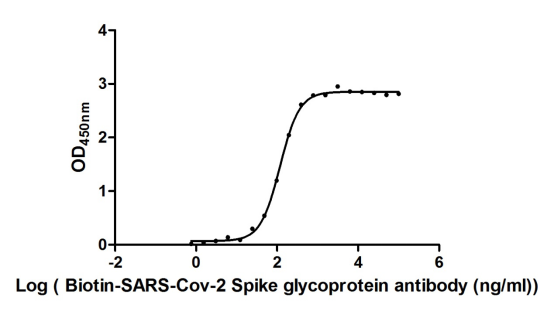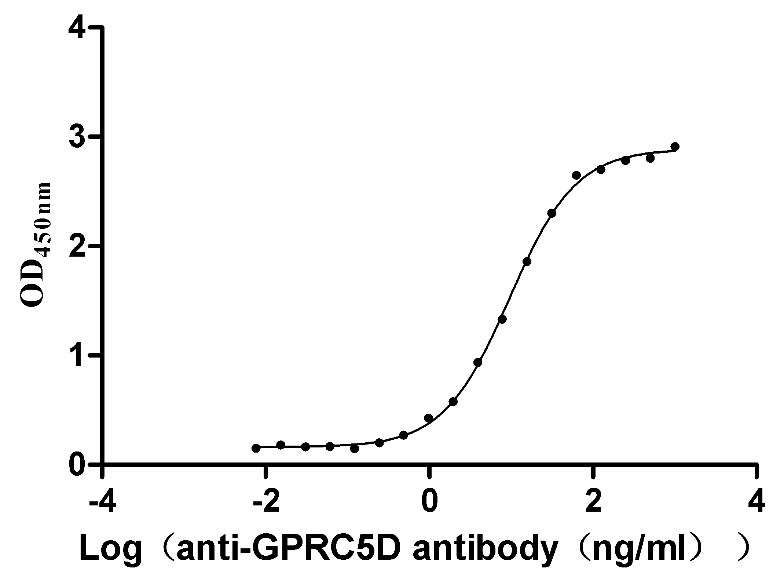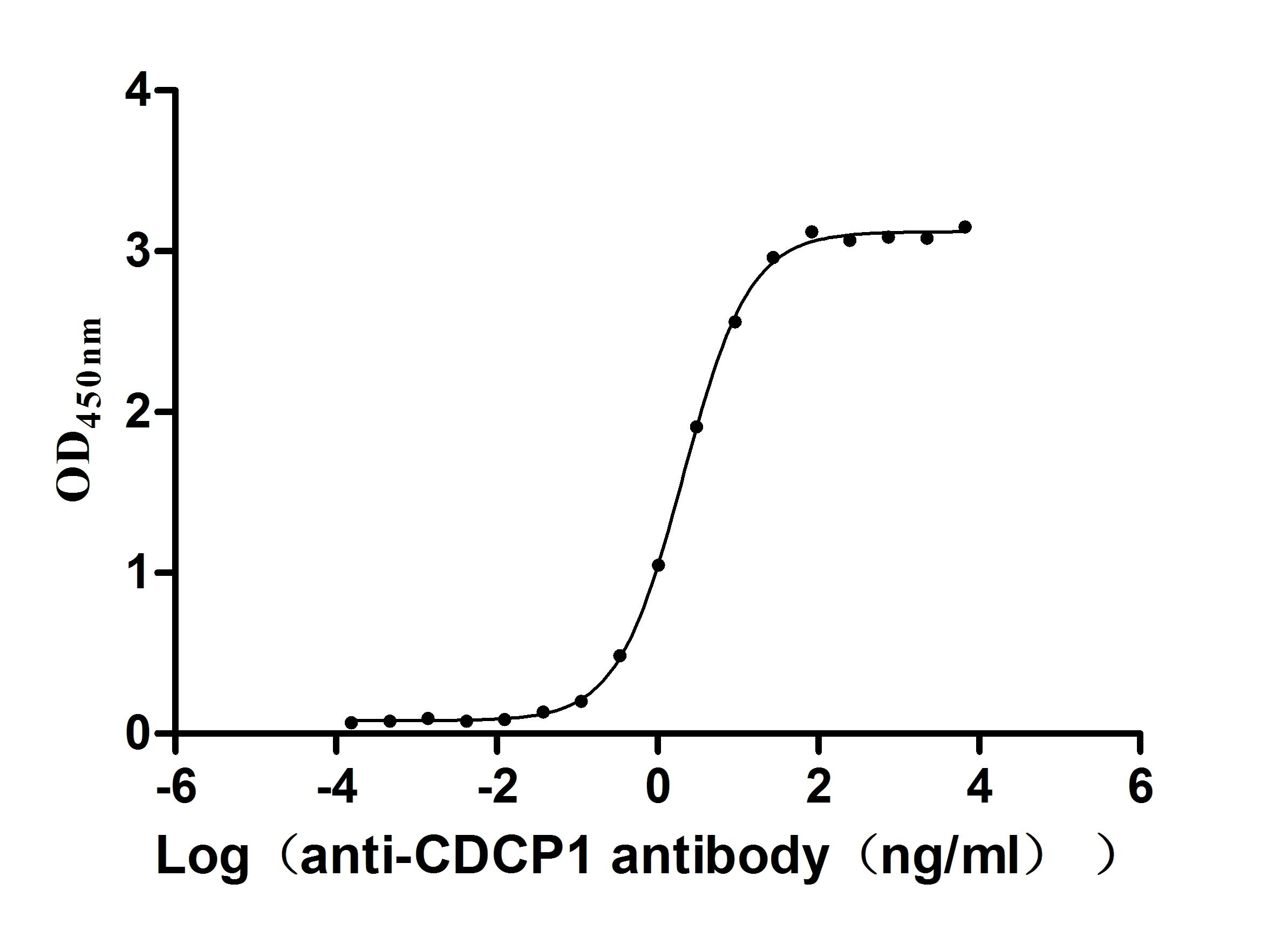Recombinant Human Leucine-rich repeat and immunoglobulin-like domain-containing nogo receptor-interacting protein 1 (LINGO1), partial
-
中文名称:人LINGO1重组蛋白
-
货号:CSB-YP839321HU
-
规格:
-
来源:Yeast
-
其他:
-
中文名称:人LINGO1重组蛋白
-
货号:CSB-EP839321HU-B
-
规格:
-
来源:E.coli
-
共轭:Avi-tag Biotinylated
E. coli biotin ligase (BirA) is highly specific in covalently attaching biotin to the 15 amino acid AviTag peptide. This recombinant protein was biotinylated in vivo by AviTag-BirA technology, which method is BriA catalyzes amide linkage between the biotin and the specific lysine of the AviTag.
-
其他:
-
中文名称:人LINGO1重组蛋白
-
货号:CSB-BP839321HU
-
规格:
-
来源:Baculovirus
-
其他:
-
中文名称:人LINGO1重组蛋白
-
货号:CSB-MP839321HU
-
规格:
-
来源:Mammalian cell
-
其他:
产品详情
-
纯度:>85% (SDS-PAGE)
-
基因名:LINGO1
-
Uniprot No.:
-
别名:FLJ14594; LERN 1; LERN1; Leucine rich repeat and Ig domain containing 1; Leucine rich repeat neuronal 6A; Leucine rich repeat neuronal protein 1; Leucine rich repeat neuronal protein 6A; Leucine-rich repeat and immunoglobilin domain-containing protein 1; Leucine-rich repeat and immunoglobulin-like domain-containing nogo receptor-interacting protein 1; Leucine-rich repeat neuronal protein 1; Leucine-rich repeat neuronal protein 6A; LIGO1_HUMAN; Lingo 1; LINGO1; LRR and Ig domain containing Nogo Receptor interating protein; Lrrn 6a; Lrrn6a; Lrrn6a protein; MGC17422; Nogo Receptor interacting protein; PRO227; UNQ201
-
种属:Homo sapiens (Human)
-
蛋白长度:Partial
-
蛋白标签:Tag type will be determined during the manufacturing process.
The tag type will be determined during production process. If you have specified tag type, please tell us and we will develop the specified tag preferentially. -
产品提供形式:Lyophilized powder
Note: We will preferentially ship the format that we have in stock, however, if you have any special requirement for the format, please remark your requirement when placing the order, we will prepare according to your demand. -
复溶:We recommend that this vial be briefly centrifuged prior to opening to bring the contents to the bottom. Please reconstitute protein in deionized sterile water to a concentration of 0.1-1.0 mg/mL.We recommend to add 5-50% of glycerol (final concentration) and aliquot for long-term storage at -20℃/-80℃. Our default final concentration of glycerol is 50%. Customers could use it as reference.
-
储存条件:Store at -20°C/-80°C upon receipt, aliquoting is necessary for mutiple use. Avoid repeated freeze-thaw cycles.
-
保质期:The shelf life is related to many factors, storage state, buffer ingredients, storage temperature and the stability of the protein itself.
Generally, the shelf life of liquid form is 6 months at -20°C/-80°C. The shelf life of lyophilized form is 12 months at -20°C/-80°C. -
货期:Delivery time may differ from different purchasing way or location, please kindly consult your local distributors for specific delivery time.Note: All of our proteins are default shipped with normal blue ice packs, if you request to ship with dry ice, please communicate with us in advance and extra fees will be charged.
-
注意事项:Repeated freezing and thawing is not recommended. Store working aliquots at 4°C for up to one week.
-
Datasheet :Please contact us to get it.
相关产品
靶点详情
-
功能:Functional component of the Nogo receptor signaling complex (RTN4R/NGFR) in RhoA activation responsible for some inhibition of axonal regeneration by myelin-associated factors. Is also an important negative regulator of oligodentrocyte differentiation and axonal myelination. Acts in conjunction with RTN4 and RTN4R in regulating neuronal precursor cell motility during cortical development.
-
基因功能参考文献:
- We identified homozygous missense variants in LINGO1, p.(Arg290His) in family F162 and p.(Tyr288Cys) in family PKMR65. Both variants were predicted to be pathogenic, and segregated with the phenotype in the respective families. Molecular modeling of LINGO1 suggests that both variants interfere with the glycosylation of the protein. PMID: 28837161
- LINGO1 rs11856808 plays a protective role by decreasing the risk for PD, but not for MSA, in Chinese population. PMID: 26254004
- LINGO1 protein acts as a gateway protein internalizing into the tumor cells when engaged by antibody and can carry antibody conjugated with drugs to kill Ewing sarcoma cells. PMID: 26979953
- The results of this study show Increased LINGO1 in the cerebellum of essential tremor patients. PMID: 24531928
- Lingo-1 signaling is altered in the schizophrenia brain. PMID: 24448210
- LINGO-1 can directly bind to ErbB2, block ErbB2 translocation into lipid rafts, and inhibit its phosphorylation. PMID: 24583087
- This review found that several gene variants in the LINGO1 gene may increase the risk of essential tremor. PMID: 23682623
- LINGO1 variants are associated with essential tremor in Chinese Han female patients. PMID: 23754655
- This study demonistrated that theLINGO1 rs9652490 and rs11856808 polymorphisms are not associated with risk for multiple sclerosis. PMID: 23574883
- Results of a meta-analysis suggest a relationship between LINGO1 rs11856808 polymorphism and risk of essential tremor (ET) and familial ET, while rs9652490 polymorphism is only associated with the risk for familial ET. PMID: 22425540
- the N-terminal region containing the leucine-rich repeats along with the transmembrane and cytoplasmic domains of LINGO-1 are not required for self-interaction or interaction with amyloid precursor protein PMID: 22133804
- the present meta-analysis does not support the notion that LINGO1 rs9652490 SNP is a major genetic risk factor for parkinson disease.[meta-analysis] PMID: 22710005
- This study showed that LINGO1 rs9652490 and rs11856808 are not associated with the risk of Parkinson's disease. PMID: 21955595
- LINGO-1, a transmembrane signaling protein, inhibits oligodendrocyte differentiation and myelination through intercellular self-interactions PMID: 22514275
- There were no significant differences in frequencies for all alleles between the essential tremor (ET) group and controls; however, an association of genotype A/G of the SNP rs9652490 with the familial ET phenotype was found. PMID: 21741293
- Single nucleotide polymorphism(SNP)s of LINGO1 play a role in the development of Parkinson's disease in the Italian population. PMID: 21752692
- LINGO1 variants are not a major risk factor for developing familial essential tremor in this population, which suggests the existence of other genetic risk factors responsible for familial essential tremor in this movement disorder clinic population. PMID: 21219542
- while there were no significant differences in the Lingo1 minor allele frequency and genotype frequency between Chinese essential tremor and controls, pooled analysis showed a higher proportion of GG genotype in tremor patients PMID: 21158743
- No significant differences are found in genotype and allele distribution in the rs9652490 variant of LINGO1 in either Chinese or Caucasian Parkinson disease patients. PMID: 20951767
- This study demonistrated that LINGO1 variants could increase risk of PD, specifically those presenting the non-rigid-akinetic phenotypes, which suggests that LINGO1 may have a role in the etiology of tremor in PD at least in the Spanish population. PMID: 21506150
- genotyping results lead us to conclude that no association exists between the key variant rs9652490 and Essential tremor (P(corr) = 1.00). PMID: 21264305
- LINGO1 variant rs9652490 (A > G) is unlikely to play a major role in Parkinson's disease in Chinese populations. PMID: 20957646
- LINGO-1 inhibits multiple aspects of oligodendrocyte differentiation independently of the LRRs via a process that requires p75(NTR) signalling PMID: 20659559
- LINGO1 and LINGO2 variants are associated with essential tremor and Parkinson disease PMID: 20369371
- The two markers rs9652490 and rs11856808 were not strongly related to the essential tremor,late onset sporadic Parkinson's disease, but the rs9652490G allele might be a protective factor for the early onset Parkinson's disease in Chinese population. PMID: 20600614
- The LINGO1 gene is a risk factor for essential tremor in a Caucasian population in North America. PMID: 20372186
- Our study gives further evidence that LINGO1 acts as a susceptibility gene for essential tremor. PMID: 20310002
- Thisdy demonstrateda significant association between LINGO1 rs9652490 and essential tremor (P = 0.014) and Parkinson disease (P = 0.0003), thus providing the first evidence of a genetic link between both diseases. PMID: 19720553
- LINGO1 SNP (rs9652490) is not associated with sporadic PD in our Polish cohort. PMID: 20117178
- In this study, SNPs rs9652490, rs11856808, and rs7177008 of LINGO1 were genotyped in a total of 694 Austrian subjects (349 PD, 345 controls). No association could be found between genotype or allele counts and Parkinson disease. PMID: 19908305
- The LERN1 expression pattern is specific to the central nervous system, highly and broadly expressed during early stages of development and gradually restricted to forebrain structures as development proceeds(LERN1) PMID: 14686891
- the Lingo-1 ectodomain is a module implicated in central nervous system repair inhibition PMID: 17005555
- inhibitory agents of LINGO-1 activity can protect dopaminergic neurons against degeneration PMID: 17726113
- Variant in the sequence of the LINGO1 gene confers risk of essential tremor. PMID: 19182806
- Quick identification of essential N-glycosylation sites of a heavily glycosylated neuroglycoprotein Lingo-1, which are sufficient for the support of its surface expression. PMID: 19254717
- the LINGO1 gene is associated with an increased risk for essential tremor PMID: 19553813
- LINGO1 variant increases risk of familial essential tremor. PMID: 19805735
显示更多
收起更多
-
亚细胞定位:Cell membrane; Single-pass type I membrane protein.
-
组织特异性:Expressed exclusively in the central nervous system. Highest level in the in amygdala, hippocampus, thalamus and cerebral cortex. In the rest of the brain a basal expression seems to be always present. Up-regulated in substantia nigra neurons from Parkins
-
数据库链接:
HGNC: 21205
OMIM: 609791
KEGG: hsa:84894
STRING: 9606.ENSP00000347451
UniGene: Hs.656765
Most popular with customers
-
Recombinant Severe acute respiratory syndrome coronavirus 2 Spike glycoprotein (S), partial (Active)
Express system: Mammalian cell
Species: Severe acute respiratory syndrome coronavirus 2 (2019-nCoV) (SARS-CoV-2)
-
Recombinant Human IGF-like family receptor 1 (IGFLR1), partial (Active)
Express system: Mammalian cell
Species: Homo sapiens (Human)
-
Recombinant Human E3 ubiquitin-protein ligase ZNRF3 (ZNRF3), partial (Active)
Express system: Mammalian cell
Species: Homo sapiens (Human)
-
Recombinant Human G-protein coupled receptor family C group 5 member D (GPRC5D)-VLPs (Active)
Express system: Mammalian cell
Species: Homo sapiens (Human)
-
Recombinant Macaca fascicularis CD93 molecule (CD93), partial (Active)
Express system: Mammalian cell
Species: Macaca fascicularis (Crab-eating macaque) (Cynomolgus monkey)
-
Recombinant Human Claudin-3 (CLDN3)-VLPs (Active)
Express system: Mammalian cell
Species: Homo sapiens (Human)
-
Recombinant Human Cytotoxic and regulatory T-cell molecule (CRTAM), partial (Active)
Express system: Mammalian cell
Species: Homo sapiens (Human)
-
Recombinant Macaca fascicularis CUB domain containing protein 1 (CDCP1), partial (Active)
Express system: Mammalian cell
Species: Macaca fascicularis (Crab-eating macaque) (Cynomolgus monkey)




















